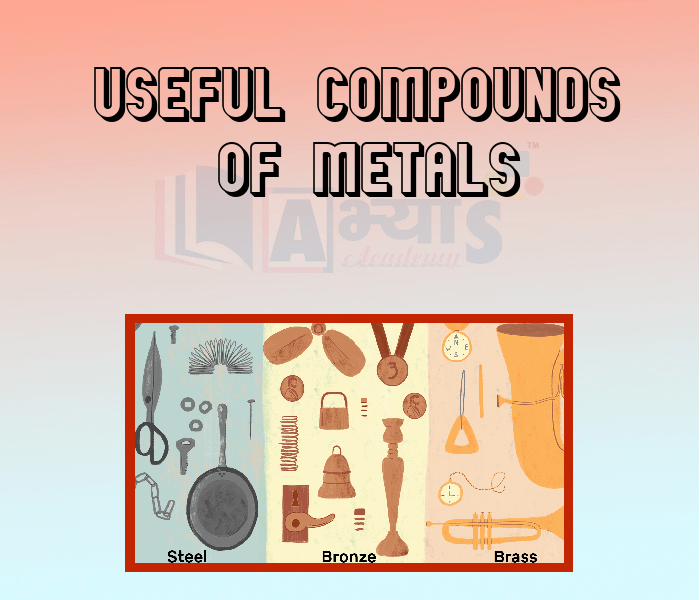Useful Compounds Of Metals










Useful Compounds Of Metals
Some Useful Compounds of Metals: Common Salt: Common salt is sodium chloride (NaCl). Common salt, when kept open, absorbs moisture from air. This is because of the presence of magnesium chloride in common salt. Magnesium chloride is deliquescent, that is, it absorbs water.
Sodium chloride is very important chemical. It is an essential ingredient in our daily meal. It can be converted into useful chemicals like caustic soda, washing soda and baking soda. It also yields hydrochloric acid, an important chemical used in chemical industry, and chlorine, which is used as a bleaching agent.
Caustic Soda: Chemically, caustic soda is sodium hydroxide (NaOH). It is obtained by electrolysis of brine (NaCl solution).
Washing Soda: Washing soda is sodium carbonate decahydrate . Sodium carbonate (soda ash) is alkaline in nature and has detergent (cleaning) properties. In a crystalline state, it possesses water crystallisation. On exposure to air, crystals lose water and turn into white opaque powder. Sodium carbonate is used as a cleansing agent for domestic purposes. It is also used for softening of hard water, in manufacturing of chemical like borax, caustic soda, glass and water glass. It is a constituent of many dry soap powders.
Baking Soda: The chemical name of baking soda is sodium hydrogen carbonate (). Sodium bicarbonate is used in the manufacture of baking powders and health salts.
Lime Calcium oxide is commonly known as quicklime or just lime. It is prepared by heating limestone () in a kiln.Calcium oxide reacts vigorously with water producing slaked lime [
], which is used for making mortar and for white washing.
A solution of slaked lime is known as lime water, which is used for testing carbon dioxide. Calcium oxide is used for making cement and glass.
Bleaching Powder: The chemical name of bleaching powder is calcium oxychloride (). Bleaching powder is commonly used for bleaching in laundries. It is used in paper and textile industries, for disinfecting water and preparation of chloroform.
Plaster of Paris: It is a calcium sulphate hemihydrate [].
Faster of Paris has a remarkable property of hardening when mixed with proper quantity of water.The hardening of Plaster of Paris is due to its hydration to form gypsum. It is used in the laboratories for sealing the gaps, where sunlight arrangement is required. It is also used for making casts for statues, and in surgery to maintain joints in a fixed position.
Students / Parents Reviews [10]
One of the best institutes to develope a child interest in studies.Provides SST and English knowledge also unlike other institutes. Teachers are co operative and friendly online tests andPPT develope practical knowledge also.

Aman Kumar Shrivastava
10thMy experience with Abhyas is very good. I have learnt many things here like vedic maths and reasoning also. Teachers here first take our doubts and then there are assignments to verify our weak points.

Shivam Rana
7thAbout Abhyas metholodology the teachers are very nice and hardworking toward students.The Centre Head Mrs Anu Sethi is also a brilliant teacher.Abhyas has taught me how to overcome problems and has always taken my doubts and suppoeted me.

Shreya Shrivastava
8thAbhyas is a complete education Institute. Here extreme care is taken by teacher with the help of regular exam. Extra classes also conducted by the institute, if the student is weak.

Om Umang
10thBeing a parent, I saw my daughter improvement in her studies by seeing a good result in all day to day compititive exam TMO, NSO, IEO etc and as well as studies. I have got a fruitful result from my daughter.

Prisha Gupta
8thIt was good as the experience because as we had come here we had been improved in a such envirnment created here.Extra is taught which is beneficial for future.

Eshan Arora
8thMy experience was very good with Abhyas academy. I am studying here from 6th class and I am satisfied by its results in my life. I improved a lot here ahead of school syllabus.

Ayan Ghosh
8thMy experience with Abhyas academy is very good. I did not think that my every subject coming here will be so strong. The main thing is that the online tests had made me learn here more things.

Hiya Gupta
8thIt was a good experience with Abhyas Academy. I even faced problems in starting but slowly and steadily overcomed. Especially reasoning classes helped me a lot.

Cheshta
10thIt has a great methodology. Students here can get analysis to their test quickly.We can learn easily through PPTs and the testing methods are good. We know that where we have to practice
